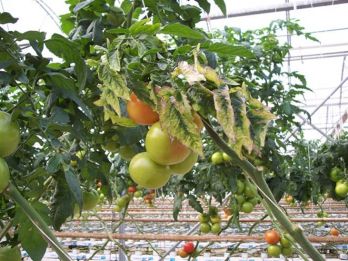Potato spindle tuber viroid disease
Potato spindle tuber viroid disease (PSTVd) is a quarantinable pathogen that mainly affects the growth of potato and tomato crops.
Background
PSTVd was first reported in North America, found in isolated pockets of northern and northeastern USA and Canada.
Through movement of infected potato tubers, it has spread to Asia, Africa, South America, Europe, China, and New Zealand. PSTVd has also been found in tomatoes in Western Australia, Queensland New South Wales and South Australia.
In potatoes, severe PSTVd strains have caused losses of up to 65% in tuber number and size. In tomatoes, losses of 40 to 50% in yield have been reported.
Impacts
PSTVd affects a range of hosts, including potato, tomato, capsicum, eggplant, chilli, avocado, sweet cucumber, and sweet potato.
The PSTVd agent is stable and reaches exceptionally high concentration within infected plants. It is highly contagious, transmitted through:
- direct contact of small wounds in the leaf surface of healthy and diseased plants
- contaminated machinery, clothing, cutting or pruning tools
- aphids from plants also infected with potato leafroll virus
- movement of animals through crops
- infected potato tubers
- pollen
- potato and tomato true seeds.
Management
Control PSTVd using biosecurity practices to limit spread between growing facilities. This includes:
- inspecting your crops regularly and reporting unusual growth
- using pest-free propagation material and seedlings, sourced from a reputable supplier
- keeping equipment and vehicles clean and free of plant matter
- wearing clean clothing before visiting other growers’ properties
- teaching on-farm hygiene practices to all workers and visitors.
Identification
Symptoms of PSTVd are difficult to diagnose as expression depends on the strain of the viroid, plant cultivar infected, and climatic conditions. It can be confused with nutrient imbalances, spray damage, or other plant diseases.
PSTVd is more pronounced under high light intensity and temperature. It can develop into mild and severe strains. Many cultivars of potato and tomato may be symptomless and act as carriers of the disease.
The first signs of PSTVd infection in tomato are growth reduction and chlorosis in the top of the plant. This may result in stunting and turn into reddening or purpling, with leaves becoming brittle. Stunting is usually permanent, causing flower and fruit initiation stop. However, plants may either die or partially recover.
Foliar symptoms of potato include an upright and stunted growth habit, with an erect stem. It will have shortened internodes between leaflets, which are smaller with a rugose and overlapping appearance. Infected potato tubers are elongated with pointed ends. They have deeper eyes than normal, and the tuber skin is cracked. On severely affected tubers, knobs and swellings may appear.

